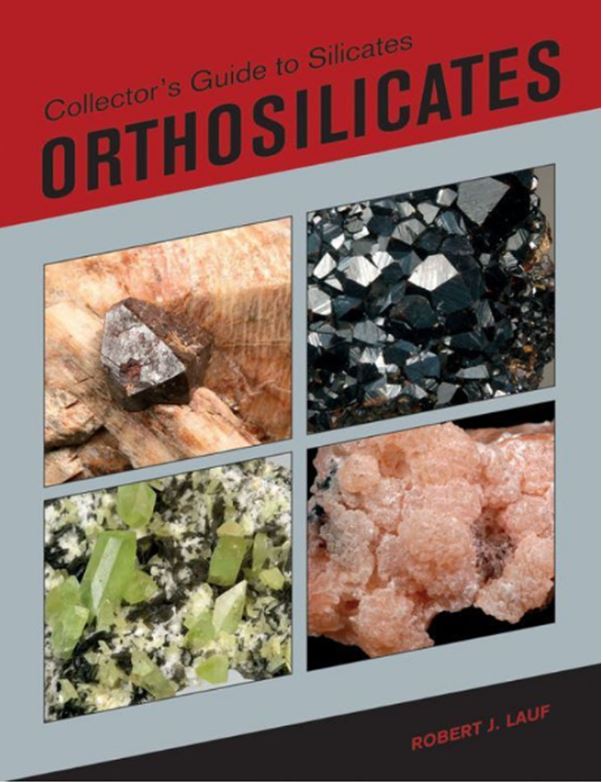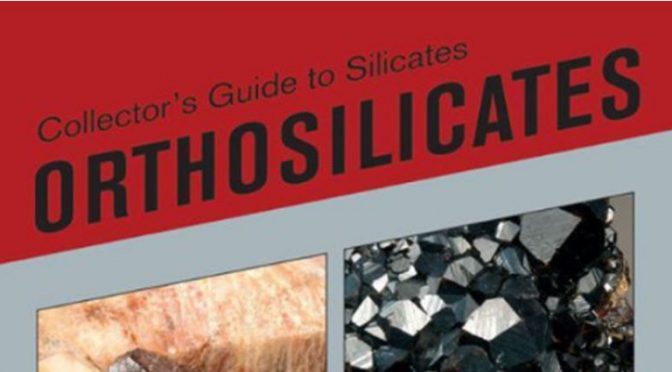What do you call chemical compounds that are comprised of isolated silica tetrahedron: that is, where the tetrahedrons do not share any corner oxygens with other tetrahedron, but rather are connected by cations in various configurations? Why, orthosilicates, of course. Olivine, garnets, zircon, staurolite, and topaz are orthosilicates, to name a few. So is titanite, one of our favorite Bancroft, Ontario minerals.
When Dr. Robert Lauf arrived at the Rochester Mineralogy Symposium in April he was carting several boxes of his newly minted book entitled “Collector’s Guide to the Silicates: Orthosilicates”. After his Friday morning talk on the topic, the line to obtain signed copies was predictably long. I got there early to secure mine, but I do believe Robert was prepared and everyone who desired a signed copy at the symposium was rewarded.

The 238 page treatise is the first of what is planned to be a six volume set Dr. Lauf is writing on silicate mineralogy. But this series of books is different from most mineralogy texts you will find. The books are written for collectors and not for professional mineralogists. That does not mean that they are skimpy on supportive detail or mineralogy input, quite the contrary. But it does mean that reading and understanding the text does not require a degree in mineralogy.
The book is organized by mineral group. Starting with olivine and carrying through humite, zircon, garnet, and much more, each section naturally discusses mineralogy (structure, morphology, and chemistry), but also contains input on formation and occurrence, and a section on alteration and pseudomorphs. Lauf acknowledges that the book is not comprehensive in its coverage of all known minerals in each group, but it is unlikely most collectors will run into an orthosilicate that is not included.
One section that particularly appealed to me was on the alumino-silicate group of kyanite-andalusite-sillimanite. We all love the unique blue kyanite from North Carolina or Brazil and WCGMC members who have collected at Benson Mines in Star Lake all have some sillimanite from the magnetite-rich gneiss there. We may even have andalusite in schists from Connecticut in our collections. But did you know these three metamorphic minerals (polymorphs with formula Al2SiO5) are of paramount importance to metamorphic geologists? If not, you might find Lauf’s succinct explanation of the temperature and pressure controls on the occurrence of these three minerals enlightening.
Perhaps even better than the text are the supportive illustrations. There are 467 figures sprinkled through the volume. Aside form the forward pages, I could not find a page lacking a figure or photograph. Some are diagrams depicting chemical composition or crystal structure, but most are exquisite photographs of orthosilicate minerals carefully selected to illustrate specific features. They are nice specimens, wonderfully photographed, but this is not a catalog of best of species museum specimens. It is a volume designed to teach and illustrate and it does both remarkably well. Each caption contains scale information and clearly states the location where the specimen originated. For reference geeks, the book has 16 pages full of them!
The full size hardcover book is published by Schiffer Publishing Ltd. and lists for $45.00, but it can be obtained for about $30 by judicious online shopping. I am certain it will be one of the first books I refer to when seeking input on “anything orthosilicate” and I will probably also spend time simply perusing the fine specimen photographs. I cannot wait for Robert to publish volumes 2-6.
FULL REFERENCE:
Lauf, Robert, J., 2017, Collector’s Guide to Silicates: Orthosilicates, Schiffer Publishing LTD., 249 p.
